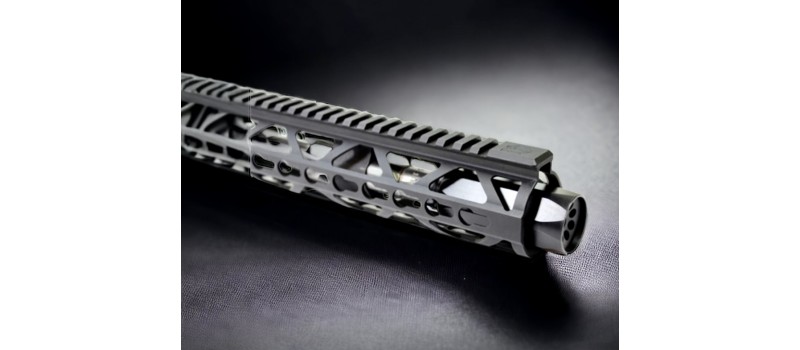When it comes to optimizing the performance of your 458 SOCOM rifle, one crucial element that often gets overlooked is the proper buffer weight. The buffer system in big bore rifles plays a significant role in managing recoil and ensuring smooth cycling of the action. If the buffer is too light, the action may not cycle properly, which can lead to malfunctions, such as failure to feed or the bolt not locking back on the last round. In this blog post, I will delve into the importance of selecting the right buffer weight for your 458 SOCOM rifle, with a particular emphasis on why the 4.3 carbine heavy buffer is the golden standard for optimal performance of your big bore.
The Role of the Buffer System in Big Bore Beasts
As someone deeply immersed in the world of firearms, especially the robust 458 SOCOM, I've come to appreciate the intricate dance of parts that work in harmony within these big bore beasts. At the heart of this harmonious operation is the buffer system - an unsung hero in managing the beastly recoil these rifles are known for. My journey into understanding and optimizing the performance of 458 SOCOM rifles led me to realize the pivotal role that a properly weighted buffer plays, not just as a recoil management tool, but as a cornerstone of the rifle's reliability and smoothness of operation.
From my first-hand experiences, I've observed that the buffer system in big bore rifles is more than just a shock absorber. It's the linchpin that ensures the symphony of moving parts operates in sync. When you fire a 458 SOCOM, the energy unleashed is monumental. The buffer's job is to take that brute force and tame it, ensuring that the action cycles back smoothly and ready for the next round. A well-chosen buffer weight acts as a precise counterbalance to the violent energy, preventing the harsh metal-on-metal impact that can lead to excessive wear on the rifle's internals.
The buffer does more than protect the rifle; it protects the shooter's experience. Without a buffer system meticulously matched to the rifle's requirements, shooters might find themselves wrestling with a rifle that feels more like a wild bronco than a precision instrument. Bolt bounce, a common issue with inadequately buffered big bore rifles, is a clear sign of this imbalance. It's disheartening, to say the least, when you're aiming for precision and your rifle's bolt is bouncing like a jackhammer, throwing off your rhythm and accuracy.
Moreover, the harmonization facilitated by the buffer system extends beyond just managing recoil. It affects the rifle's entire operational cycle. Each shot fired is a test of this balance, and with the right buffer weight, such as the 4.3 heavy buffer I advocate for, the rifle cycles with a fluidity that feels almost organic. It’s this seamless operation that elevates shooting from a mere mechanical action to a truly gratifying experience, where each round fired is a testament to the harmony between shooter and rifle.
In this quest for the perfect shooting experience with my 458 SOCOM, the buffer system emerged not just as a component, but as a critical ally.
The Golden Weight: Why 4.3 is the Magic Number
In my pursuit of perfection within the realm of the 458 SOCOM, I've embarked on a meticulous journey to understand every facet of its operation. This journey led me to a profound realization about the integral role of the buffer system, specifically the magic of the 4.3 heavy buffer. This isn't just a number pulled from the ether; it's the culmination of exhaustive testing, research, and real-world experience.
To me, the 4.3 heavy buffer is not just a piece of hardware; it's the heart of achieving a symphony between power and precision. With a buffer too light, I've witnessed the chaos of uncontrolled cycling - the rifle becomes erratic, unreliable. Each round feels like a gamble, not just on accuracy but on whether the action will complete its cycle without hiccup. The frustration of a malfunction when you're lined up for that perfect shot is more than just a nuisance; it detracts from the very essence of shooting.
Conversely, an overly heavy buffer stifles the rifle's operation, like trying to run with weights on your ankles. The action drags, and with each shot, the rifle's response feels dampened, sluggish. It's akin to a sports car filled with the wrong fuel; the potential for performance is there, but it's bogged down by an unsuitable component.
That's where the 4.3 heavy buffer shines - it hits the sweet spot. It's like finding the perfect rhythm in a dance, where every movement is fluid, every step is sure. This buffer weight allows the 458 SOCOM to express its full potential, channeling its immense power into a controlled, graceful cycle of operation. Shots feel smoother, the recoil becomes a manageable push rather than a disruptive force, and reliability becomes the standard, not the exception.
This isn't just about making do; it's about refusing to compromise. Why settle for a performance that's merely adequate when you can achieve one that's exemplary? The 4.3 heavy buffer is my testament to this belief, a cornerstone of my shooting philosophy. It's the difference between a rifle that simply works and one that works wonders.
The Perils of Underweight Buffers in the .458 SOCOM
Venturing into the realm of .458 SOCOM rifles with an underweight buffer is a path I learned to avoid early on in my shooting journey. It's akin to entering a battlefield ill-equipped, where the outcome is predictably fraught with unnecessary challenges and disappointment. The underweight buffer, in its inadequacy, lays the groundwork for a series of issues that extend beyond mere operational hiccups to impact the very core of the rifle's performance and longevity.
From my personal experience, the repercussions of using an underweight buffer manifest in several, increasingly frustrating ways. The rifle becomes temperamental, akin to a high-performance engine running on low-octane fuel. The action’s cycle feels rushed and incomplete, leading to a symphony of failures – to feed, to extract, and to eject. Each round becomes a roll of the dice, not just on where it will land but if it will properly cycle at all. Imagine the moment of anticipation as you pull the trigger, only to be met with the silence of a failure to feed; it’s not just an interruption—it’s an absolute breakdown in the dialogue between shooter and rifle.
But the perils of an underweight buffer extend beyond the frustration of malfunctions. They delve deeper, into the very heart of the rifle, exerting undue stress on its internal components. This is where the unseen damage accumulates, like waves eroding a cliff face, unseen until the structure weakens. The bolt carrier group, the heart that pumps life into each shot, faces the brunt of this force, accelerating wear and tear, potentially leading to premature failure. It's a silent adversary, one that undermines the rifle from the inside out, compromising its integrity and reliability.
Engaging with a .458 SOCOM rifle, for me, is an exercise in precision and power, a balance that’s thrown off kilter by an underweight buffer. It’s a lesson in the importance of harmony between all components, where even the seemingly inconsequential weight of a buffer can dictate the line between a seamless performance and a battle against the rifle itself. The journey to optimize my .458 SOCOM rifle was a testament to this balance, a realization that every detail matters in the pursuit of perfection.
The Impact of the Right Buffer on Performance and Durability
Choosing the right buffer weight for my 458 SOCOM rifle was a game-changer. Before I discovered the 4.3 heavy buffer, I was essentially holding back the true potential of my rifle. It's like driving a high-performance sports car with the handbrake on; you know there's power under the hood, but you're not quite harnessing it. But once I made the switch, the transformation was palpable.
The immediate difference was in the felt recoil. It's no secret that the 458 SOCOM can pack a punch, but with the right buffer, that punch becomes a firm, manageable push. This isn't just about comfort—it's about control. Reducing muzzle rise isn't merely a convenience; it's a crucial factor in follow-up shots and overall accuracy. Every time I pull the trigger now, I'm not bracing for the kick; I'm readying myself for the next shot, confident in my control over the rifle.
But it's not just the shooting experience that improved; it's the rifle's health. I consider my 458 SOCOM an investment, not just a tool. And like any good investment, it needs protection. The proper buffer acts like a shock absorber, cushioning the internal components against the violent energy unleashed with every shot. This protection translates into less wear and tear on the rifle, ensuring its longevity and reliability. The peace of mind that comes with knowing my rifle is operating smoothly and sustainably is invaluable.
To me, investing in a 4.3 heavy buffer was a no-brainer. It's a small adjustment that yields significant dividends, from enhancing shooting ability to safeguarding my rifle's integrity. It's one of those rare instances where a simple tweak unlocks a world of performance and durability. And for anyone passionate about their 458 SOCOM rifle, it's an adjustment that simply makes sense.





